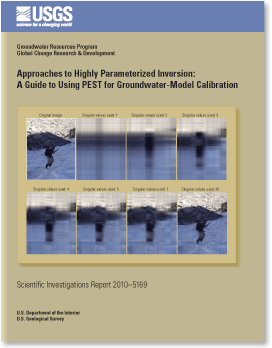Scientific Investigations Report 2010-5169

ABSTRACTHighly parameterized groundwater models can create calibration difficulties. Regularized inversion—the combined use of large numbers of parameters with mathematical approaches for stable parameter estimation—is becoming a common approach to address these difficulties and enhance the transfer of information contained in field measurements to parameters used to model that system. Though commonly used in other industries, regularized inversion is somewhat imperfectly understood in the groundwater field. There is concern that this unfamiliarity can lead to underuse, and misuse, of the methodology. This document is constructed to facilitate the appropriate use of regularized inversion for calibrating highly parameterized groundwater models. The presentation is directed at an intermediate- to advanced-level modeler, and it focuses on the PEST software suite—a frequently used tool for highly parameterized model calibration and one that is widely supported by commercial graphical user interfaces. A brief overview of the regularized inversion approach is provided, and techniques for mathematical regularization offered by PEST are outlined, including Tikhonov, subspace, and hybrid schemes. Guidelines for applying regularized inversion techniques are presented after a logical progression of steps for building suitable PEST input. The discussion starts with use of pilot points as a parameterization device and processing/grouping observations to form multicomponent objective functions. A description of potential parameter solution methodologies and resources available through the PEST software and its supporting utility programs follows. Directing the parameter-estimation process through PEST control variables is then discussed, including guidance for monitoring and optimizing the performance of PEST. Comprehensive listings of PEST control variables, and of the roles performed by PEST utility support programs, are presented in the appendixes. |
First Posted November 2010
For additional information contact: Part or all of this report is presented in Portable Document Format (PDF); the latest version of Adobe Reader or similar software is required to view it. Download the latest version of Adobe Reader, free of charge. |
Doherty, J.E., and Hunt, R.J., 2010, Approaches to highly parameterized inversion—A guide to using PEST for groundwater-model calibration: U.S. Geological Survey Scientific Investigations Report 2010–5169, 59 p.
Abstract
Introduction
Purpose and Scope
Regularized Inversion
Before Running PEST: Model Parameterization
Before Running PEST: Observations Used in Inversion Process
Before Running PEST: Preparing the Run Files
Running PEST
Monitoring PEST Performance
Evaluation of Results
Other Issues
Summary of Guidelines
References
Appendix 1. Basic PEST Input
Appendix 2. PEST Utilities
Appendix 3. Groundwater Data Utilities
Appendix 4. Singular Value Decomposition Theory